It’s no secret that in the past few months, there has been a labor shortage across Canada. With the pandemic, many have taken the opportunity to make a career change and others to return to school. Certain industries such as construction, food service, events and manufacturing have been hardest hit by the labor shortage.
As a result, there are more and more headhunters active on social networks and companies are more open to offering flexible benefits. Recruiting staff is becoming a real headache for some organizations, especially when their financial means are limited compared to those of the competition.
Recruiting from a newsletter can therefore become a very advantageous solution.
Why recruit from a newsletter?
First of all, it is an effective way to directly reach those who show an interest in your brand. A subscriber will not necessarily intend to come and work for your company; however, they may spread the word when they see your ad to friends, co-workers or family.
Maybe some of your contacts are just looking for a new opportunity? In that case, BINGO! Chances are, they’ll decide to check out the job posting or your career site if the description matches their criteria.
In any case, you have nothing to lose by letting your friends and family know that you are looking for staff. However, you must be careful and not overdo it in the number of recruitment emails you send; otherwise you risk losing subscribers.
Tips and tricks for writing your recruitment newsletter
1) Talk about career development rather than a job opening
Some candidates like to know what the possibilities are for advancement within your company so they can visualize their future. A company that invests in the progression of its employees is seen as a winning option and the candidate will feel a sense of security and stability.
Fun fact: Better opportunities for advancement are one of the top motivations for changing jobs for both blue-collar (30%) and white-collar (35%) Canadians. –Randstad
2) Put your advantages forward
In Canada, workers change jobs an average of 15 times in a lifetime. Among the elements that encourage workers to change jobs are the opportunities for advancement, the culture, but also the benefits. Promote the benefits of coming to work at your company and try to stand out from the competition.
Benefits refer to salary, vacation time, insurance, RRSPs, available training and any other monetary benefit. Some companies even decide to be original by paying a trip to the south for their employees or by owning a cottage that allows employees to work remotely.
Fun fact: According to Randstad research, both blue- and white-collar workers see pay as the number one motivation for changing jobs. In fact, 65% of blue-collar workers and 60% of white-collar workers would consider changing jobs for better pay. – Randstad
3) Show your corporate culture
People appreciate working for a company that shares their values and vision. By showing a glimpse of your company culture, it helps you create an identity and distance yourself from the competition.
Generally, companies that share an inspiring culture will tend to receive more applications and employees will tend to be more loyal.
4) Be honest
The temptation to embellish a position can be tempting, but beware if the content of your email does not live up to your promise, your candidates will be disappointed and will look elsewhere. Eventually, this can also damage the company’s reputation.
5) Follow up
Send a confirmation email when someone sends their resume. It shows the candidate that you have received their application and that you will pay close attention to their profile.
6) Integrate an action button (CTA)
Don’t forget to include a CTA leading to your job posting or to the career page of your website. Without a button, people won’t know where to look at your job posting or how to apply.
Some examples of recruitment newsletters:
Sail:
Subject line : ? We’re hiring now !
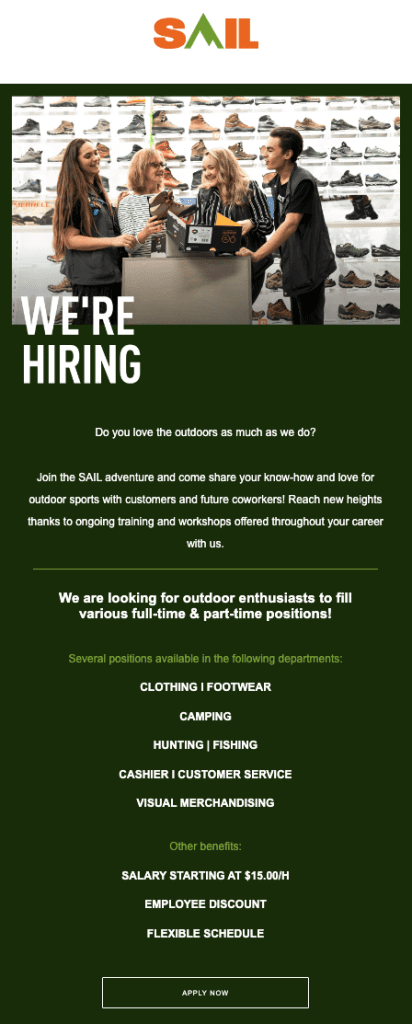
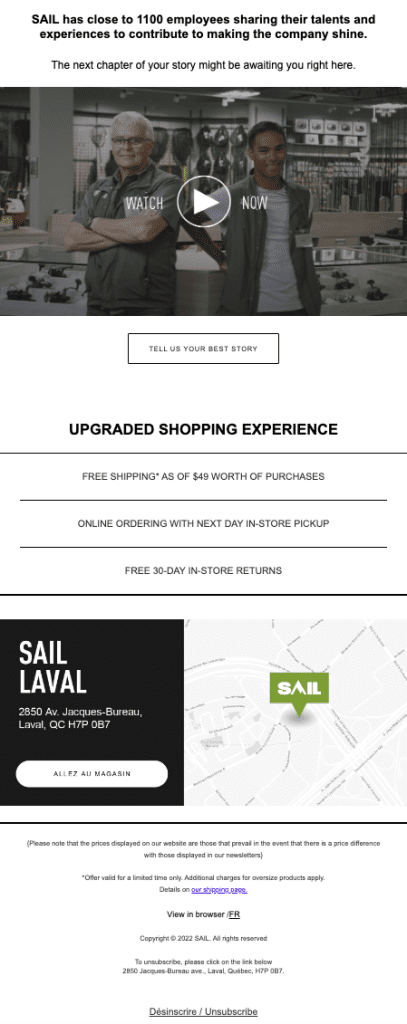
Sail has decided to emphasize that by coming to work for the company, you will be with other people who have the same passions as you, such as nature and outdoor activities. In addition, the retail store shows some of the benefits of coming to work for the company as well as a promotional video that introduces your future co-workers and the tasks you could perform.
Finally, putting photos and testimonials from employees gives a more human touch to the newsletter.
Bixi:
Subject line : __FIRSTNAME__, we are hiring! ➡
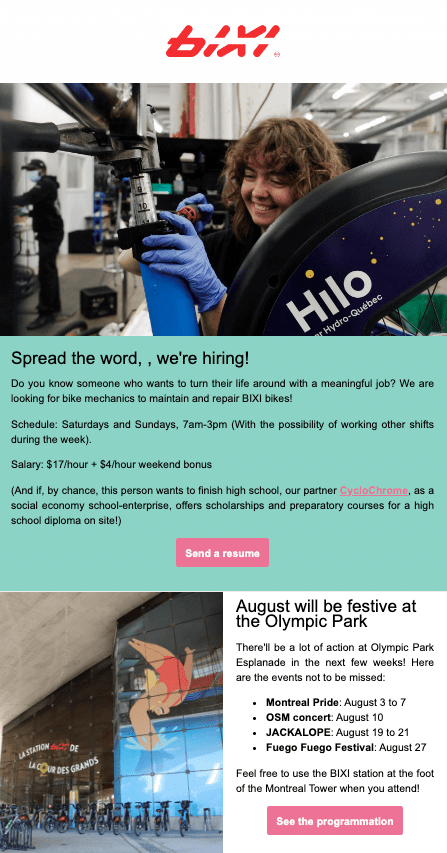
Bixi has decided to put forward the work schedule, the salary and the fact that if you are a student, help is offered for your studies.
Zapier:
Subject line : New in October: Automation ideas for you and your business, 7 updates, and 18 new apps

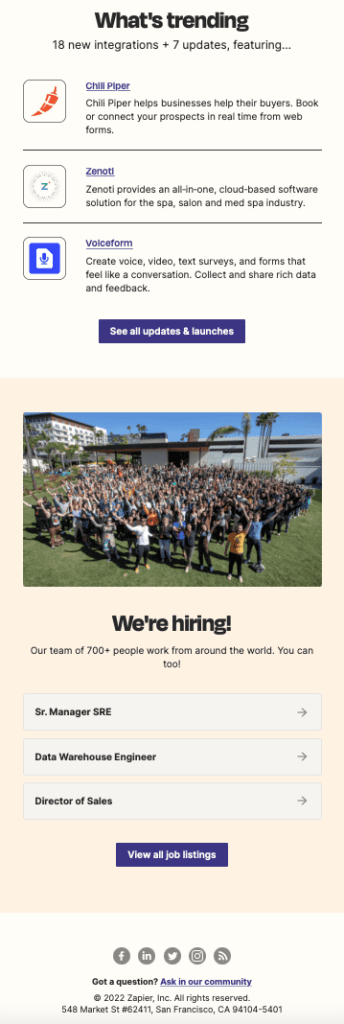
In Zapier’s email, the recruitment block is located at the end of the newsletter and does not represent the main news. There is a group photo of employees specifying that there are over 700 workers at Zapier worldwide and the current positions available. Finally, there is a CTA that leads to the company’s career page. It is a simple and efficient way to advertise opportunities within your company.
Staples:
Subject line : ? Last Chance – Up to $70 off headphones
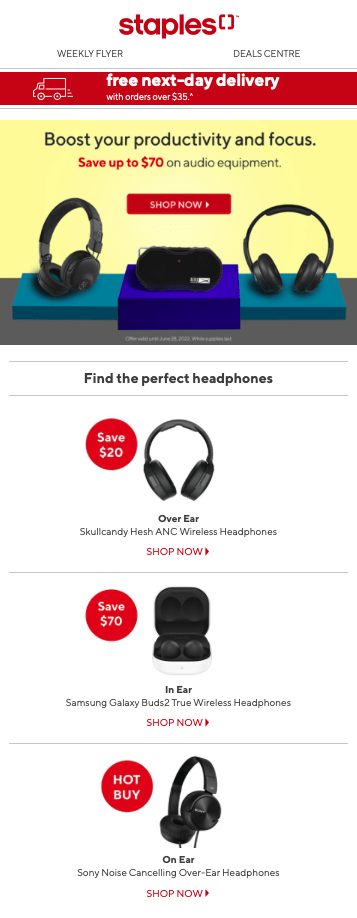
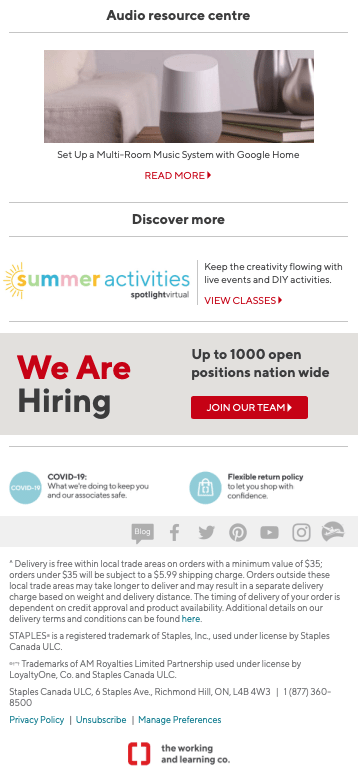
Staples is another example of an email where the main news is not about recruitment. It’s a small, simple block with a headline, a descriptive sentence which mentions that many positions are available around the world with a CTA leading to the career page of the website. This is a block that can easily be reused in other newsletters since it doesn’t take up much space.
Altitude Sports:
Subject line : Win your dream Wishlist, up to $500

Altitude Sports simply decided to insert in their footer the search for a developer and that they are open to remote work. The CTA leads to the job description.
Cyberimpact
Subject line : Spell Check and Team Building
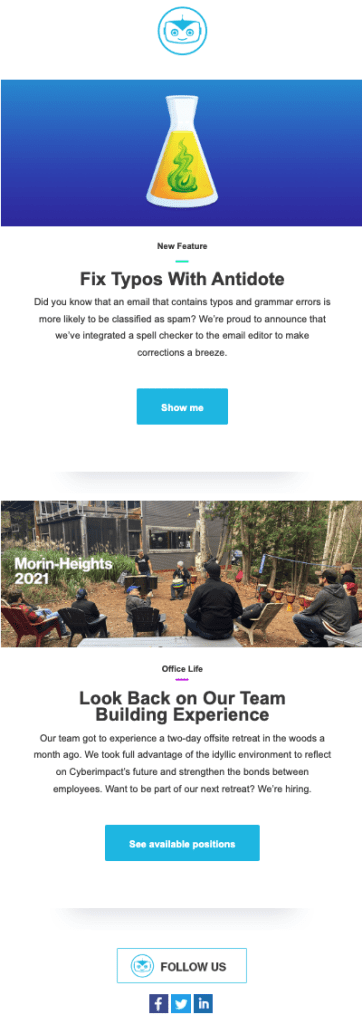
Here is an example we did in the past. Instead of saying we were recruiting, we put a picture of a team-building activity and a description of the weekend between employees. However, the CTA leads to the career page and invites people to see the opportunities offered at Cyberimpact if they want to be part of our next retreat.
Send your recruitment email campaign
You now have the knowledge to send out your very first recruitment campaign, so it’s up to you!
